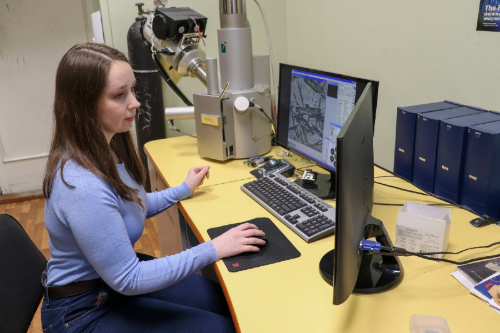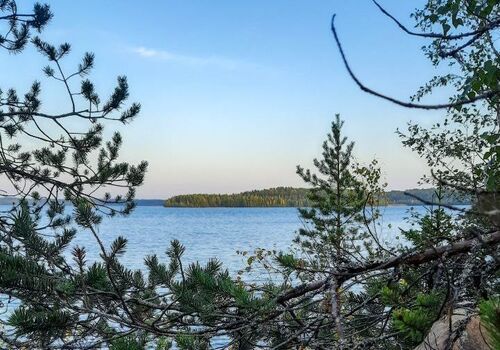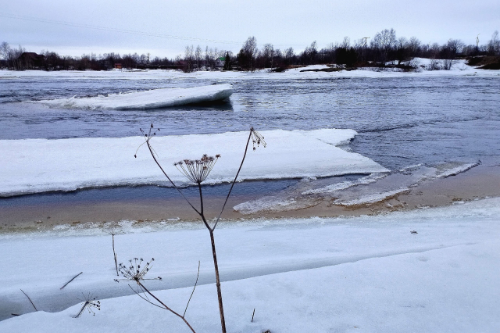Shungite rock is a large group of Precambrian carbon-bearing formations about 2 billion years old, varying in the formation environment and composition. Shungite deposits are located in Karelia, mainly in Zaonezhye. Shungite is used in the metal industry, in construction, for water filtration, and in decorative arts. It has never been used in high-tech processes so far.
– The main obstacle to its wider use is the high variability of the mineral and chemical composition of shungite rock. Different properties can appear even within the same deposit for the same variety. To get rid of this variability and obtain reproducible material, we supposed that the raw material can be unified by going down to the nanoscale. We did so and got rid of the main impurities. The result was films 3 microns thin with a controlled structure and, most importantly, with reproducible, stable, properties," said Anna Kovalchuk, Researcher at the Laboratory for Physicochemical Study of Nanomaterials of the Institute of Geology KarRC RAS.
The results produced by a team of scientists from Karelia and St. Petersburg were published in the international journal CurrentNanoscience.
The making of the films was preceded by another development, created and patented by the Institute of Geology KarRC RAS - aqueous dispersions of shungite carbon. This is a suspension of shungite carbon nanoparticles in water. Assessment of the dispersions showed that the structure of the nanoparticles was graphene-like. Meanwhile, graphene is currently the best theoretically studied modification of carbon, and because of the proven similarity, the theoretical background available in this field can be applied also to shungite nanomaterials.
In particular, graphene films are known to be susceptible to various gases. In her work, Anna Kovalchuk confirmed that shugite carbon films have the ability to sorb and desorb oxygen, and the resistance of the films changes in the process. Owing to this property, they can be used in gas sensors. The problem is that the current methods of making graphene-based films require special, technologically complex conditions and additional materials. As a result, only small samples not applicable in the industry can so far be obtained in laboratory conditions.
The challenge for scientists was to simplify the production process and create a cost-effective way to obtain high-quality carbon film. For this purpose the researchers chose natural shungite carbon as the source of graphene fragments.
In one of the methods, films were condensed from solutions on glass substrates. In another method, the dispersion step was skipped: films were obtained directly from shungite carbon powder by thermal deposition in a small vacuum thermal chamber at a temperature below 750°С.
– Technologically, this method is simple and economical. The powder input is small, no special gases or high vacuums are required, which means that the production conditions are mild, - Anna Kovalchuk explained.
Apart from the structure, the scientists also checked the electrophysical properties of the resultant materials, in particular the electrical conductivity at high frequencies. Using oxygen as the example, they monitored what happens to the film when the gas is absorbed and released. The stability of the properties, the practicality and cost-effectiveness of the method makes it promising for the industry. Furthermore, having high transparency, carbon films can be used in the manufacturing of optical devices.
On February 11, the web portal of the Russian Ministry of Higher Education and Science published a story dedicated to the International Day of Women and Girls in Science, where Anna Kovalchuk was one of the stars.
News

February 11, 2023
Scientists create thin films of shungite carbon for the first time. Shungite is now mainly used in the metal industry, construction, and for water purification. The new development opens up possibilities for its high-tech use, for example, for making gas sensors, as well as in optical devices.
See also:

July 7, 2025
A successful introduction: the zander has settled down in Lake Sundozero and continues to spread
Scientists of the Institute of Biology KarRC RAS have published the results of long-term observations over the population of the zander (or pikeperch) introduced to Lake Sundozero more than a half-century ago. They confirm the species has become naturalized. Maintaining the population requires regulation of harvesting, protection during spawning, and tending of spawning grounds.
Scientists of the Institute of Biology KarRC RAS have published the results of long-term observations over the population of the zander (or pikeperch) introduced to Lake Sundozero more than a half-century ago. They confirm the species has become naturalized. Maintaining the population requires regulation of harvesting, protection during spawning, and tending of spawning grounds.

June 26, 2025
Ice-related phenomena on rivers emptying into the White Sea now last three weeks less than 60 years before
Ice on northern rivers now forms later while ice-off occurs earlier. Karelian scientists confirmed this having analyzed 64 years of marine and meteorological data from the estuaries of rivers draining into the White Sea along its western coast. Climate change has bit three weeks off the ice-covered period on these rivers. The reductions have been the most significant in the last 30 years, aligning with global warming trends in Arctic water bodies.
Ice on northern rivers now forms later while ice-off occurs earlier. Karelian scientists confirmed this having analyzed 64 years of marine and meteorological data from the estuaries of rivers draining into the White Sea along its western coast. Climate change has bit three weeks off the ice-covered period on these rivers. The reductions have been the most significant in the last 30 years, aligning with global warming trends in Arctic water bodies.

June 23, 2025
Citizen science and web technologies help researchers study insects of Karelia
More than 30 insect species not encountered in Karelia previously have been revealed by entomologists from KarRC RAS during their expeditions and using data communicated by active participants of the iNaturalist portal – an open platform for collecting biodiversity data.
More than 30 insect species not encountered in Karelia previously have been revealed by entomologists from KarRC RAS during their expeditions and using data communicated by active participants of the iNaturalist portal – an open platform for collecting biodiversity data.



